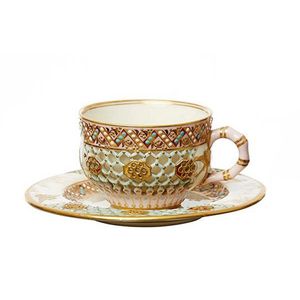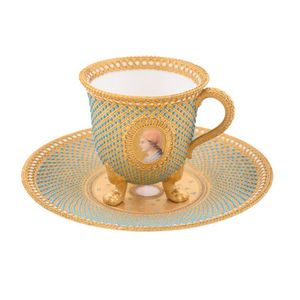Jewelled Royal Worcester Countess of Dudley Cup and Saucer
You must be a subscriber, and be logged in to view price and dealer details.
Subscribe Now to view actual auction price for this item
When you subscribe, you have the option of setting the currency in which to display prices to $Au, $US, $NZ or Stg.
- Circa - A Latin term meaning 'about', often used in the antique trade to give an approximate date for the piece, usually considered to be five years on either side of the circa year. Thus, circa 1900 means the piece was made about 1900, probably between 1895 and 1905. The expression is sometimes abbreviated to c.1900.
- Jewelled Decoration - Jewelled decoration on ceramics is a technique where small, colourful, and often metallic beads or "jewels" are applied to the surface of ceramic objects to create intricate and highly decorative designs. This technique has been used throughout history and across different cultures, but it was particularly popular during the late 19th and early 20th centuries, especially in Europe.
The jewelled decoration is usually applied by hand, one bead at a time, onto a base glaze or enamel. The beads can be made of glass, porcelain, or even precious stones, and are often set in a metal setting, such as gold or silver. The end result is a highly decorative and often luxurious surface, which can add a lot of visual interest and value to the ceramic object.
Jewelled decoration was used on a wide range of ceramic objects, including vases, plates, bowls, and figurines. It was particularly popular in the Art Nouveau and Art Deco periods, where it was used to create highly stylized and ornate designs.
This item has been included into following indexes:
Visually similar items

A large George II silver porringer, the two handled bowl with curved lobes and flutes to the lower body, the foliate framed cartouche unengraved. London 1736 by Samuel Wood. 18 x 11.5 cm

A Queen Anne two handled Britannia silver porringer London /, circa 1705 or 1697, with swirl fluted decoration, an embossed gadroon band & 'S' scroll handles, approximately 311gms silver, 10 cm high, 18.5 cm total width

Marguerite Mahood (1901-1989), a jug, a reticulated, double gourded earthenware jug, pierced to lower body, cream glaze, fluted handle, incised Marguerite Mahood, E1041 to base, 10 cm high

A Royal Worcester 'George Owen' reticulated and jewelled cup and saucer. A Royal Worcester 'George Owen' reticulated and jewelled cup and saucer, in the Japanese style reticulated panels interspersed with panels of tooled gilt cranes and butterfly, bamboo
